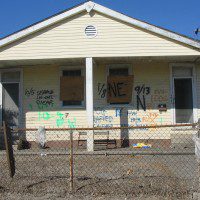1. Dr. John, “Goin’ Back to New Orleans”
1985, 1999, 2005, 2010. These are the years I’ve gone back to New Orleans to stay. If you’re driving down from the north, it’s best to cue up Dr. John’s “Goin’ Back to New Orleans” (cassette, CD, or iTune, depending on your era) right when I-55 comes to an end and merges into I-10 over the swamps edging Lake Ponchartrain. There’s a swooping flyover that rises high and then curves down onto twin bridges pointed straight east, at the city you feel before you see.
Goin’ back home, too-na-nay, to the land of the beautiful queen.
I was in Glencoe, Illinois, at my in-laws, on the night of September 23, 2005. I was happy, ecstatic. According to the TV news I’d been pacing in front of the past three weeks, New Orleans was destroyed. Big deal, I was going back. Had my ticket in my hand. If there was one floating rooftop on the sea over what used to be New Orleans, I was going back to lie on it until I died. I put on “Goin’ Back to New Orleans” and shut the door to my wife’s childhood bedroom. I closed the blinds on the leafy cool suburban pastoral outside. I pictured a New Orleans street and me dancing in it and I rocked my parade dance, an arm-chugging high-stepping march. I never was much into dancing, except in association with New Orleans. Like I couldn’t separate the basic concept of dancing from the specific place of New Orleans, where we do it in the street. I lived in Chicago for years, and the way they do it, in dark low-ceilinged pits, always struck me as uncivilized. Europeans do it that way, too. “Clubs” everybody calls them. The French term is best: boite de nuit, a night-box. Who wants to dance in a box? I’d rather dance on water.
2. Verdi, Requiem: Dies Irae
Like New Orleans parades and music acts, New Orleans history is a spectacle. We offer real-life drama, shit that other people can’t believe happens in America, and we just keep on dishing out the hits. Voodoo, Yellow Fever, sex parties, sex crimes, corruption, axe murders, violent storms. New Orleans is always already pre-apocaplytic or post-apocalyptic. We do the end of the world and then get up and do it again for the generation that hasn’t had the chance yet.
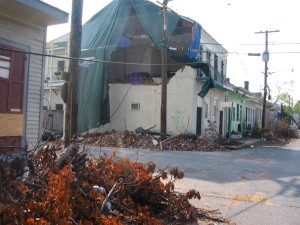 Verdi’s Dies Irae starts with four full orchestral blasts on the downbeat, followed by tortured cries of ‘dies irae!’ as the strings tumble in descending scales like everything on earth tipping into the chasm. Then the systematic punches return, this time with bass drum left hooks on the upbeat. It’s a vision of fire and flood and the vicious spirit of the universe that wallops us in the face until we have no choice but to call it beautiful. Fuck you. But I love you. Fuck you. We’re masochists for weeping at the beauty of destruction, it makes us pathetic, it’s an abandonment of our freedom and will. Divine Vengeance has its way with us. “As flies to wanton boys are we to th’ gods,” says Gloucester in King Lear.
Verdi’s Dies Irae starts with four full orchestral blasts on the downbeat, followed by tortured cries of ‘dies irae!’ as the strings tumble in descending scales like everything on earth tipping into the chasm. Then the systematic punches return, this time with bass drum left hooks on the upbeat. It’s a vision of fire and flood and the vicious spirit of the universe that wallops us in the face until we have no choice but to call it beautiful. Fuck you. But I love you. Fuck you. We’re masochists for weeping at the beauty of destruction, it makes us pathetic, it’s an abandonment of our freedom and will. Divine Vengeance has its way with us. “As flies to wanton boys are we to th’ gods,” says Gloucester in King Lear.
Dies irae, dies illa
I was feeling it after a slow drive on my first day back home. Only major routes had been cleared. Like out Elysian Fields from my house in Faubourg Marigny to the University of New Orleans campus. The shit-stripe (waterline) started around Claiborne Avenue, a few feet off the ground, along the houses and businesses on either side. It got higher and higher, then disappeared above the roofline. Roofs with jagged holes hacked out from within by people fighting for their lives. What caused the sticky brown residue slapped across every structure in a straight horizontal line? Shit. Oil. Chemicals. Dead animals and dead people. 1,500 dead people. Fuck you. And your mother. And you can’t do shit about it, so shut up.
3. Neville Brothers, “Can’t Stop the Funk”
But I went out there again, just driving around. My house is on the higher ground in the old part of the city, the “sliver by the river,” and it was very much intact. But it had no electricity, gas, water, so the car was a more comfortable place to be. I had decided that the city needed me to drive around it—especially in the miles and miles of total desolation—jamming a New Orleans funk anthem. I rolled down the windows and maxed out the volume.
We’re here, in here
Can’t stop the funk
It was mostly big trucks on the streets, city vehicles and military. And men with cellphones scribbling on pads. The 82nd Airborne was stationed a couple blocks from my house. I heard the national anthem blaring every morning early, on a tinny loudspeaker, from their temporary barracks in a coffee warehouse. They did a foot patrol every evening around sundown. Two columns walking at a steady pace past my stoop. M-16s ready but casual, pointed down. One time they came by when I was sitting in my car, charging devices and rocking “Can’t Stop the Funk.” They all glanced over as they marched past. A couple of smiles, but mostly they stayed stoic, professional. Their commander, cigar chomping Afro-Creole general Russell Honoré, was the latest military savior of the beset colony on the necessary river. The latest Andy Jackson, the latest Bernardo de Gálvez.
We’re ready, as Freddie
Can’t stop the funk
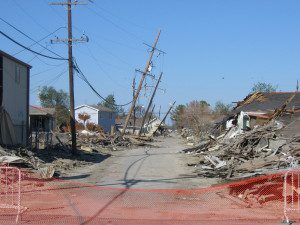 One afternoon I drove through the French Quarter and saw and smelled the insurance write-offs of a legion of restaurants. My first job, at fifteen, was at a gay neighborhood restaurant in the Quarter called the Quarter Scene, on Dumaine and Dauphine. It was the first place I got funky, though I was musically not so compatible then. It was my job on Mondays to take out the garbage from the weekend, Sunday being the one day with no garbage pick-up in the Quarter. We didn’t have an alley, and were barred from storing garbage on the sidewalk, so we stored the two-day-old food waste in a small, dark, airless closet. It was actually a long cupboard-like space, since you had to duck to fit into it. In the summer, a greasy reddish film would form outside the bags. There was no light in the little enclosure, so I’d shine a flashlight and poke the rats off with a broom. It was a crash course in getting over cockroach phobia, too. Then the bags needed to be hauled through the dining room to get to the sidewalk. The manager always fussed about why I was doing it at a particular time, rather than a mythical thirty minutes before or later. When the garbage truck pulled up, I ran out with a ten and a five, neatly folded, to hand to the garbage man—since we, like every French Quarter restaurant, were always over the weight limit.
One afternoon I drove through the French Quarter and saw and smelled the insurance write-offs of a legion of restaurants. My first job, at fifteen, was at a gay neighborhood restaurant in the Quarter called the Quarter Scene, on Dumaine and Dauphine. It was the first place I got funky, though I was musically not so compatible then. It was my job on Mondays to take out the garbage from the weekend, Sunday being the one day with no garbage pick-up in the Quarter. We didn’t have an alley, and were barred from storing garbage on the sidewalk, so we stored the two-day-old food waste in a small, dark, airless closet. It was actually a long cupboard-like space, since you had to duck to fit into it. In the summer, a greasy reddish film would form outside the bags. There was no light in the little enclosure, so I’d shine a flashlight and poke the rats off with a broom. It was a crash course in getting over cockroach phobia, too. Then the bags needed to be hauled through the dining room to get to the sidewalk. The manager always fussed about why I was doing it at a particular time, rather than a mythical thirty minutes before or later. When the garbage truck pulled up, I ran out with a ten and a five, neatly folded, to hand to the garbage man—since we, like every French Quarter restaurant, were always over the weight limit.
In late September 2005, every restaurant in the Quarter put out their month-old food waste at the same time. The whole place smelled like the rat cupboard at the Quarter Scene on a Monday morning in August. A reminder of how the old city—all old cities—probably always used to smell. Like death? But food is the source of life, and pleasure, so how can it smell like death? If you find out what stuff smells like when you’re dead, come back and let me know. Thomas Mann’s The Magic Mountain taught me years ago that rot and decay are simply the flipside of living. That living is, in fact, a process of decay, going down slow and reveling in the sensation. No sense has the power to make us feel more viscerally alive than smell.
The rats came out of the woodwork after Katrina, too. A plague of rats. They’d flocked to the higher ground in the old city, and a few shacked up with us. We put out rat traps. They squeal when they can’t unstick themselves and then you put on boots and take them out to the sidewalk and smash their heads in. The streets were dotted with rat carcasses, smashed under the big trucks driving debris everywhere. They also had their distinctive smell.
Katrina means cleansing, they said. Yes, the cleansing away of all the obfuscatory bullshit of rhetoric and reason, enabling a stark naked apprehension of living. A mud massage, full body and to completion. For those of us, that is, who’d managed to cheat death one more time.
4. Richard Strauss, “Im Abendrot”
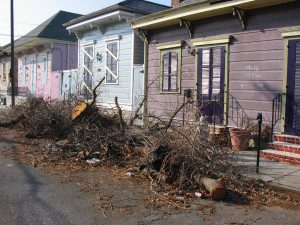 When I was in high school I was a classical music freak. My friends wanted to get down and party with the Clash or Tom Petty or the B-52s or Cameo, but I wanted to drop acid and rock out on Mahler, Stravinsky, Bartók. I blame the old-world look of my neighborhood. I pretended then that life was a movie, something I sadly am less able to do as I get older, though I appreciated Katrina for bringing back a sense of cinematic drama. I realized at a young age that my neighborhood—French Quarter and Marigny—looked like a movie set, and then we saw them filming Cat People in 1982, and I started to think I might as well approach life like it was a movie. It was a gothic movie, so the music of the late Romantics was perfect. It was the Sony Walkman era. I blew all the money that didn’t go to drugs at a big music store uptown called the Metronome. They had a separate little classical music cottage across Octavia Street from the main store, which was always crowded with people looking for everything but classical. What I couldn’t afford, I shoplifted. I figured it was their own fault for assuming punk and funk posed the security threats. My preferred route home was on my bike down Coliseum Street through the Garden District, right past the old mansion where Anne Rice sat writing about vampires. I always hoped for gray skies and a light rain, and thunderstorms were always worth the thrill.
When I was in high school I was a classical music freak. My friends wanted to get down and party with the Clash or Tom Petty or the B-52s or Cameo, but I wanted to drop acid and rock out on Mahler, Stravinsky, Bartók. I blame the old-world look of my neighborhood. I pretended then that life was a movie, something I sadly am less able to do as I get older, though I appreciated Katrina for bringing back a sense of cinematic drama. I realized at a young age that my neighborhood—French Quarter and Marigny—looked like a movie set, and then we saw them filming Cat People in 1982, and I started to think I might as well approach life like it was a movie. It was a gothic movie, so the music of the late Romantics was perfect. It was the Sony Walkman era. I blew all the money that didn’t go to drugs at a big music store uptown called the Metronome. They had a separate little classical music cottage across Octavia Street from the main store, which was always crowded with people looking for everything but classical. What I couldn’t afford, I shoplifted. I figured it was their own fault for assuming punk and funk posed the security threats. My preferred route home was on my bike down Coliseum Street through the Garden District, right past the old mansion where Anne Rice sat writing about vampires. I always hoped for gray skies and a light rain, and thunderstorms were always worth the thrill.
I scheduled music according to time of day, occasion, mood. The summer before I went off to college, I prepared to leave, I thought, forever. The perfect music was Strauss’s Four Last Songs. The camera was behind me, watching me get smaller as I coasted my bike down Chartres Street in the Lower Quarter, past the Ursuline convent, where the praying nuns turned back the great fire of 1788. In the dimming twilight, to the slow high woodwind trills and long, slow descending whole notes in the lower strings, my form melted into the hazy middle distance. I think I knew then that I was just rehearsing my actual death, when I will hear the same song on the same street.
zwei Lerchen nur noch steigen,
nachträumend in den Duft 1
5. Aaron Neville, “La Vie Dansante”
I was quite the scenester during my Chicago years, from the final notes of “Im Abendrot,” when I thought I’d laid New Orleans to rest, consigned it to dream, to the day I cued up “Goin’ Back to New Orleans” in the moving van in 1999. I figured out fast that being from New Orleans is valuable cultural capital—as long as you’re not in New Orleans. Everywhere I’ve gone—Chicago, Berlin, Dakar—people’s eyes light up when they hear I’m from New Orleans. (Except for the few brief years after Katrina, when their eyes darkened.) A lot of the guys I went to school with—most notably Harry Connick—have parlayed their NOLA capital into international stardom. For me it’s just translated to dates and jobs. Fresh out of college at Chicago’s Heartland Café, I remember sitting at the bar as the owner read over my app. “Oh, you’re from New Orleans,” he beamed. “Of course you got the job!” It turns out he and his co-owner had got the idea to open their now-iconic cafe while tripping under a live oak in Audubon Park. Thus New Orleans makes dreamers of us all.
That’s why I wander, and follow la vie dansante
“La Vie Dansante” makes me weepy with bliss. The soft strummed string-band arrangement, the mandolin solo, Linda Ronstadt’s back-up vocals. The tune lilts. It’s about the irrepressibility of “the dancing life,” wistful and joyous at the same time. A young night bathed in a Gulf breeze, or the memory of one. A New Orleans specialty: breathless abandon. “Surrender,” the crooner advises. So easy for the young, an art form for the aging.
I felt older before Katrina than I did after it.
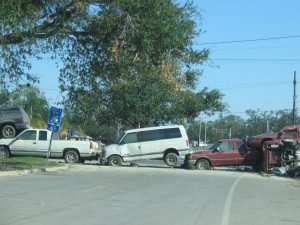 My last job in Chicago was at the Artful Dodger in Bucktown. It featured dancing, but it wan’t la vie dansante, since no breeze could make it into the box, pit, whatever, where people shook it under the neon. One of Chicago’s best-known Mardi Gras parties took place there every year, and I worked every one. But breathless abandon needs to happen outdoors. There’s nothing Mardi Gras about paying a cover to stand in a hermetically sealed drinking box. So when 1999 rolled around, I had to get back. Remember the rumors about a big breakdown of the power grid and civilization at the dawn of the new millennium? Of course I had to be in New Orleans for the end of the world.
My last job in Chicago was at the Artful Dodger in Bucktown. It featured dancing, but it wan’t la vie dansante, since no breeze could make it into the box, pit, whatever, where people shook it under the neon. One of Chicago’s best-known Mardi Gras parties took place there every year, and I worked every one. But breathless abandon needs to happen outdoors. There’s nothing Mardi Gras about paying a cover to stand in a hermetically sealed drinking box. So when 1999 rolled around, I had to get back. Remember the rumors about a big breakdown of the power grid and civilization at the dawn of the new millennium? Of course I had to be in New Orleans for the end of the world.
6. Dr. John, “Litanie des Saints”
Katrina is a loa, a voodoo deity—or loi, as they say in French, which also means “law.” Zora Neale Hurston wrote on the origins of new loas: “Some unknown natural phenomenon occurs, which cannot be explained, and a new local demigod is named.”2 It’s a no-brainer that Katrina has entered our souls to stay, and insinuated herself into the fabric of our structures and our lives. Why shouldn’t she? She proved herself with her power. People who pooh-pooh the magnitude of Katrina are disrespecting the spirits.
Dr. John gets it. His “Litanie des Saints” is a tone poem depicting the transformational essence of New Orleans, how new loas are added, layered over older ones, who also never go away. Yellow fever, crime, storms, but always love in the ruins. The invisible machinations of charmed or offended deities.
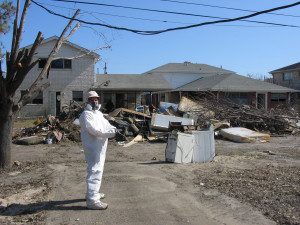 Dr. John begins with a theme of Louis Moreau Gottschalk, who rose, flared, and crashed between the years 1829 and 1869. America’s first international concert pianist was also a New Orleanian. He used to live on the corner of Royal and Esplanade and he used to stroll over to Congo Square, like many curious white Creoles, to witness the dances. His “Danse des Negres” mimics what he heard, and Dr. John re-phrases it again. Then the Neville Brothers chant the names of loas: Mama Oshun, Shango, Santa Maria, Papa Legba, Mam’sell Erzulie, Saint Cecilia. To cap off, Dr. John riffs on Gottschalk in 20th-century New Orleans style, a mild, elegant boogie. It keeps changing, nothing ever stands still, but nothing goes away.
Dr. John begins with a theme of Louis Moreau Gottschalk, who rose, flared, and crashed between the years 1829 and 1869. America’s first international concert pianist was also a New Orleanian. He used to live on the corner of Royal and Esplanade and he used to stroll over to Congo Square, like many curious white Creoles, to witness the dances. His “Danse des Negres” mimics what he heard, and Dr. John re-phrases it again. Then the Neville Brothers chant the names of loas: Mama Oshun, Shango, Santa Maria, Papa Legba, Mam’sell Erzulie, Saint Cecilia. To cap off, Dr. John riffs on Gottschalk in 20th-century New Orleans style, a mild, elegant boogie. It keeps changing, nothing ever stands still, but nothing goes away.
Katrina is here to stay. She must be paid her due.
7. Neville Brothers, “Rivers of Babylon”
But the wicked, who carried us away in captivity, required from us a song
I’d always loved being a New Orleanian away from New Orleans. But Katrina took that away from me. I became a refugee, a problem, cause for guilt, pity, anger, or resentment from other Americans. The performance of New Orleanian authenticity, once a kick, now became a test, an audition to merit continued existence, in front of a skeptical audience. The city became a diaspora, scattered. Many reported how much they liked the places they ended up. Others stewed and plotted their return.
By the rivers of Babylon, where we sat down
And there we wept, when we remembered Zion
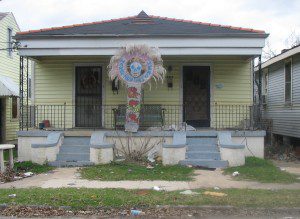 The last week of September 2005 was the only time I was in New Orleans illegally. I had to be ready with a story and a pass for all the checkpoints (I used my UNO ID, said I was a “researcher”). New Orleans resident was not a sufficient qualification. One had to be an “expert,” animal rescuer, or, of course, commercial property owner. No one was authorized to remain in the city at night, when I hid in my house with a candle and wondered about the safety of opening the back door for a breeze.
The last week of September 2005 was the only time I was in New Orleans illegally. I had to be ready with a story and a pass for all the checkpoints (I used my UNO ID, said I was a “researcher”). New Orleans resident was not a sufficient qualification. One had to be an “expert,” animal rescuer, or, of course, commercial property owner. No one was authorized to remain in the city at night, when I hid in my house with a candle and wondered about the safety of opening the back door for a breeze.
By the end of the month, Mayor Ray Nagin did the best thing he ever did: end the quarantine and let everyone come back legally. Feds and national “observers” cried out in protest, deeming the city not safe for human habitation. But C.Ray said fuck them, come on back. Thus were we restored to the bosom of New Orleans, at least those of us who could afford it, and who were driven beyond reason to hurry back.
Some hurried, some trickled. My three-year-old son and pregnant wife returned in mid-October. The boy was a spectacle. People crossed streets to look at him, slowed down their cars and rolled down their windows, sometimes even saying “thank you, thank you!” because they knew a city without children isn’t a city.
I was advised to not even open my refrigerator, just to tape it shut and get it out to the sidewalk. That’s what I did. I put cardboard under it so it wouldn’t scrape up the wood floors as I manhandled it out of there. It took off a chunk of door frame on the way out. After a month had passed, it had company. More people had come back and now refrigerators lined the street. A plague of flies buzzed all around them for blocks and blocks. One day a truck with a crane came by and hoisted them all up and into the back. People stood on their stoops and cheered.
One day I was driving around the deserted streets and I heard a brass band. I pulled over and they passed. A parade combo with snare, bass drum, trumpet, trombone, a few folks straggling behind. I smiled gleefully and gave them the thumbs-up before I realized it was a funeral.
8. Soul Rebels, “NO-LA, NO-LA, Big City of Dreams”
They haven’t done this, but they should: a New Orleans version of the Grandmaster Flash classic, “New York, New York”:
Too much, too many people, too much
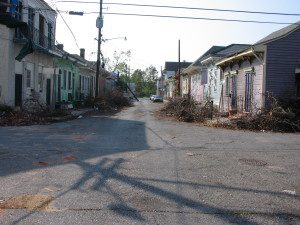 We worried if anyone would come back, beyond a tiny faithful core. But now there are too many people. Or maybe just too many cars. The streets are clogged with them, and the drivers are pissed. Struggling to get to work so they can pay their exorbitant rent. American normalcy has returned. We feared ten years ago that New Orleans would no longer be a city; now people fret about the city no longer being New Orleans. In the fall of 2005, the moving trucks were all heading away, but people came to replace the ones who left. The city is still 100,000 people smaller than before the storm, but so many more cars. The new people have more money. Many of them are tired of hearing about Katrina because they weren’t here for it. They’re also tired of hearing about themselves, especially when people call them “gentrifiers.” One worried older neighbor assured me that the newcomers would split after the first Katrina-level event—which is always on the way. But they’re New Orleanians now, another layer on top of the older layers. One day they may experience their own apocalypse, a storm or a bullet to the face. Verdi’s Dies Irae or Strauss’ last song on Chartres Street. Then we’ll know they are us. Everyone who dies in New Orleans is a New Orleanian. Their spirits will stay here forever.
We worried if anyone would come back, beyond a tiny faithful core. But now there are too many people. Or maybe just too many cars. The streets are clogged with them, and the drivers are pissed. Struggling to get to work so they can pay their exorbitant rent. American normalcy has returned. We feared ten years ago that New Orleans would no longer be a city; now people fret about the city no longer being New Orleans. In the fall of 2005, the moving trucks were all heading away, but people came to replace the ones who left. The city is still 100,000 people smaller than before the storm, but so many more cars. The new people have more money. Many of them are tired of hearing about Katrina because they weren’t here for it. They’re also tired of hearing about themselves, especially when people call them “gentrifiers.” One worried older neighbor assured me that the newcomers would split after the first Katrina-level event—which is always on the way. But they’re New Orleanians now, another layer on top of the older layers. One day they may experience their own apocalypse, a storm or a bullet to the face. Verdi’s Dies Irae or Strauss’ last song on Chartres Street. Then we’ll know they are us. Everyone who dies in New Orleans is a New Orleanian. Their spirits will stay here forever.
New Orleans is hot again, a destination, New Orleans is “back.” But I’ll always remember the miles of blocks of empty houses, the dark, silent, powerless nights, the plague of rats, the plague of flies, the empty ruin with no one in it except the handful who couldn’t bear to be away.
***
A Spotify playlist of most of these songs can be found here.
***
1. Only two sky-larks still climb, night-dreaming in the scented air (trans. CWC)↩
2. Quoted in Ishmael Reed, Mumbo Jumbo, 1972 (11)↩
